Amritsari dal recipe with step by step photos. This Dal Amritsari or Langarwali dal is a simple and tasty lentil dish from the Punjabi cuisine made with whole black gram (urad dal) and split black chickpea (chana dal). It is a rich and filling lentil curry best enjoyed with a side of Indian flatbreads like roti, naan, paratha or with steamed basmati rice.
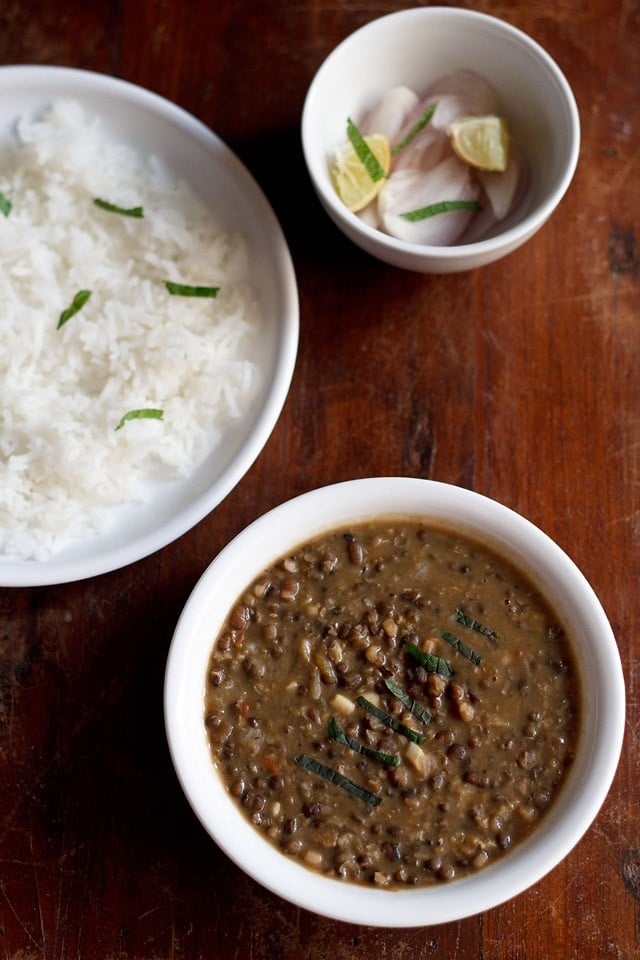
This dal is called Amritsari dal as it is quite a popular dal made and served by a Dhaba (roadside eatery) outside the Golden Temple in Amritsar, Punjab. For the first time I had made the Dal Amritsari with the recipe adapted from Jigg’s Kalra book – “Prashad cooking with Indian masters” .
I have adapted this recipe to suit our taste buds and have been making it for many years now. It is one of our favorite lentil dish.
The Dal Amritsari is made from two lentils – whole black gram (sabut urad dal) and spilt bengal gram (chana dal). There are no spice powders or spices added to the dal. A dal bursting with simple rustic flavors and subtle sweetness. The next day the dal tastes even more better like the way Dal Makhani tastes. This dal does have a faint resemblance to dal makhani though.
This Amritsari dal is also called as Langarwali dal. It is a slow-cooked delicacy. Since I do not have the luxury of time to do slow cooking, I use a pressure cooker for cooking the lentils. However, traditionally the lentils are cooked and simmered in a pot.
For best results, the lentils should be ideally cooked in a pot. So if you have the time and the patience to cook this slow-cooked wonder in a pot, then please do so. Another slow-cooked dal that is quite popular is this Dal Bukhara.
The langarwali dal is made with oil, but when traditionally served, a dollop of butter is added on top and garnished with mint leaves. You can have the dal hot or warm with chapati, naan, paratha, tandoori roti or steamed basmati rice.
How to make Amritsari Dal
Preparing the lentils:
1. Rinse 1 cup of whole black gram (urad dal) a couple of times in water. Best to use fresh lentils within their shelf life. Also make sure the lentils are not aged as then they take more time to cook.
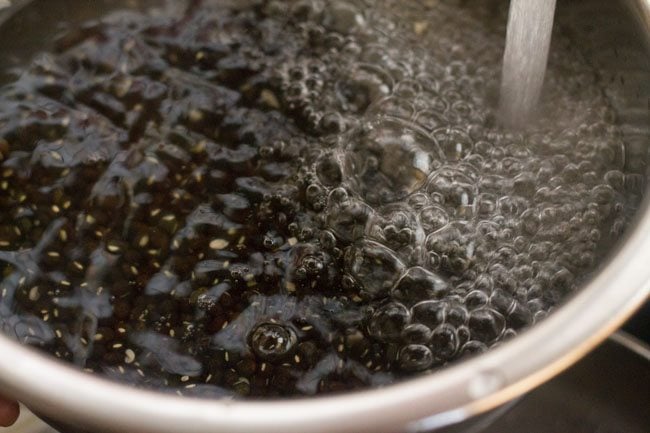
2. Soak them in enough water in a bowl overnight or for 4 to 5 hours.
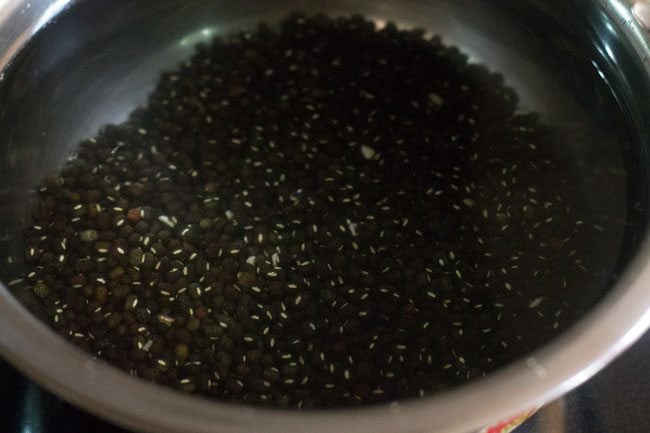
3. Similarly rinse Bengal gram (chana dal or split chickpea) a couple of times in water and soak them in enough water for 4 to 5 hours.
You can soak both the lentils together or soak separately. I have soaked them separately to show each lentil’s texture in the photo.
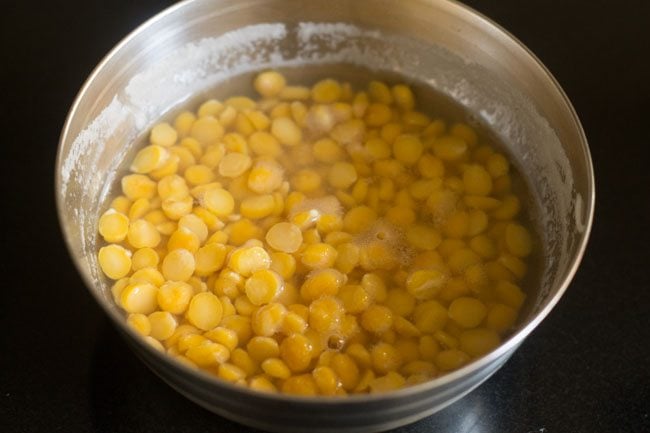
4. Drain the soaked lentils. Then in a 3 litre stovetop pressure cooker add both the soaked lentils.
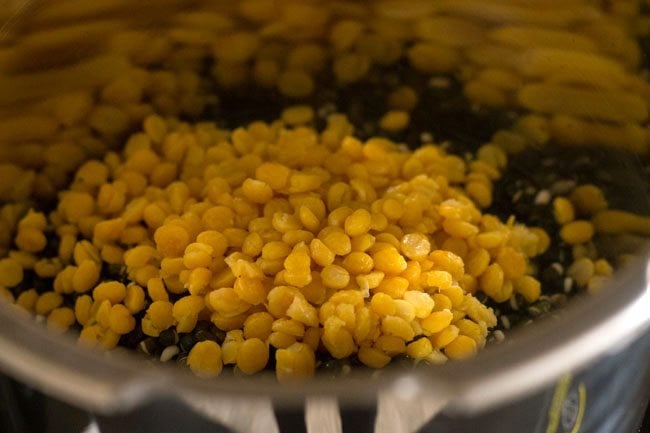
5. Next add 1.5 tablespoons of chopped ginger and 1.5 tablespoons of chopped garlic.
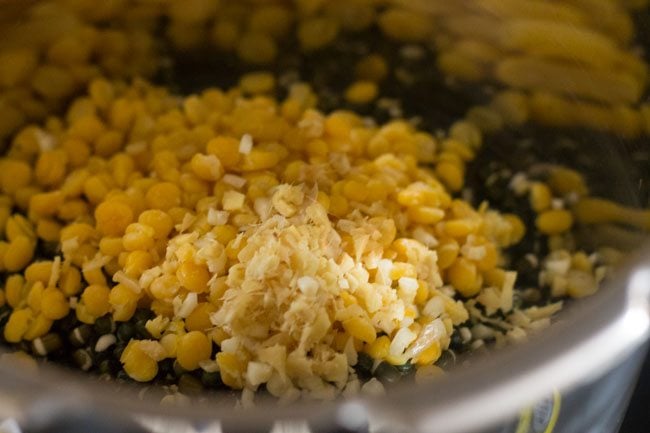
6. Pour 4 to 4.5 cups of water or as required.
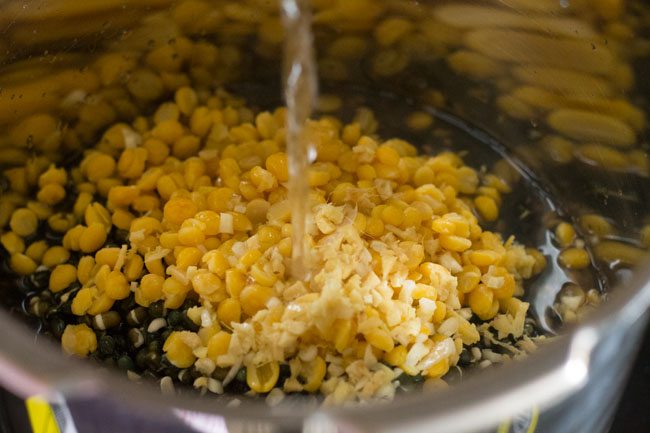
7. Pressure cook the lentils for 15 to 18 minutes on medium to medium-high heat until they are softened and mushy as shown in the below photo.
Make sure the lentils are thoroughly cooked and tender. They should not have any bite to them and should not be undercooked.
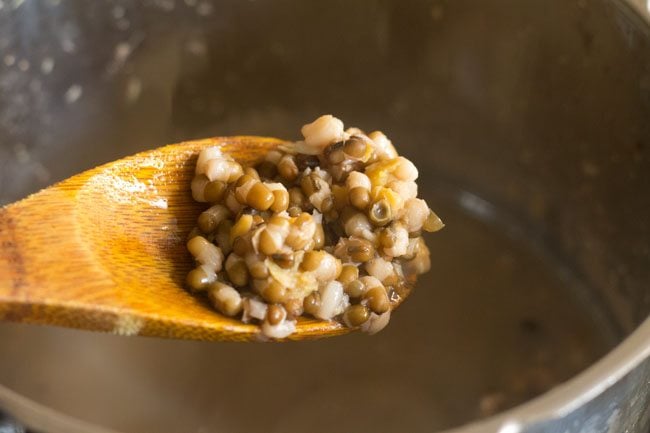
8. Then with a back of a wooden spoon, mash some of the lentils. Mashing a few lentils helps to thicken the dal.
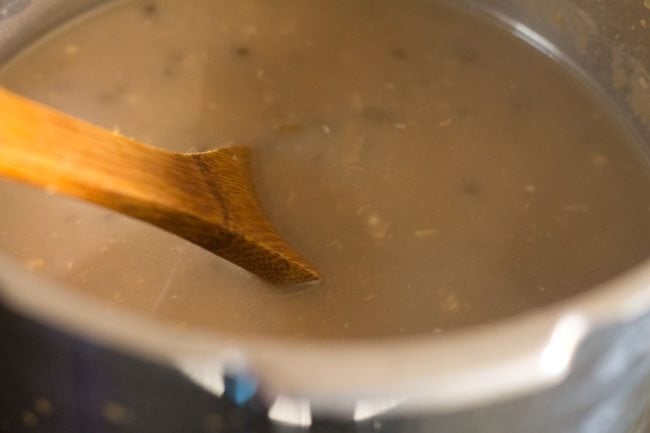
Making tempering for langarwali dal
9. Measure and keep all the ingredients ready for tempering.
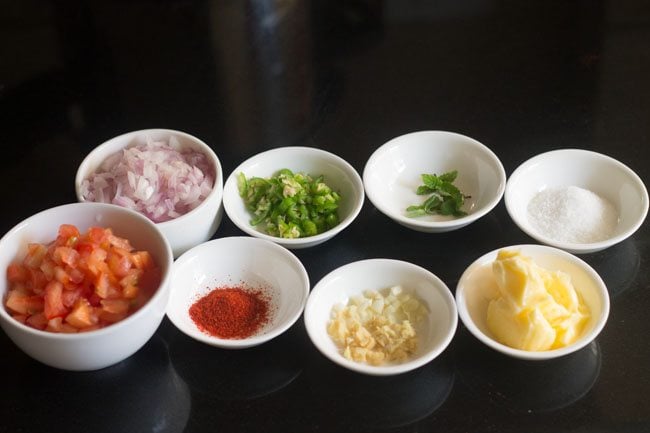
10. Heat 2.5 to 3 tablespoons of oil or butter or ghee in a small pan. I have used butter but you can use any neutral flavored oil as well. You can use either salted or unsalted butter.
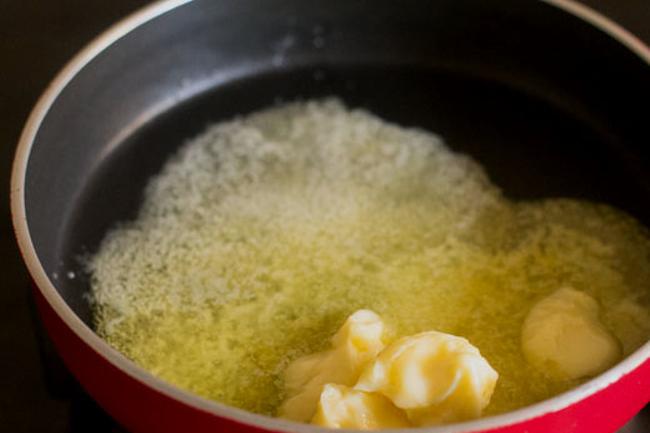
11. Then add 1 small to medium-sized finely chopped onion.
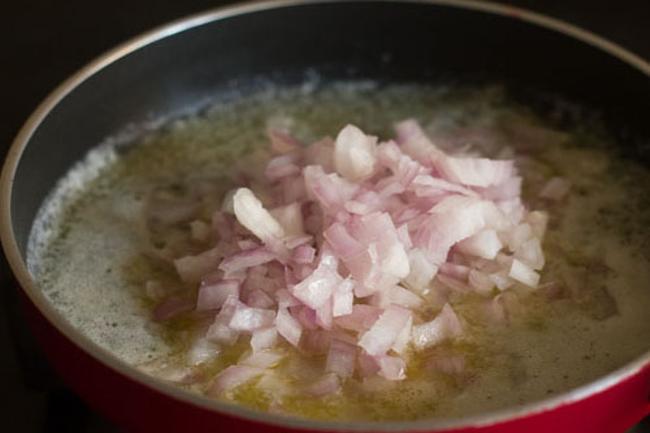
12. Saute the onions stirring often till it begins to light brown.
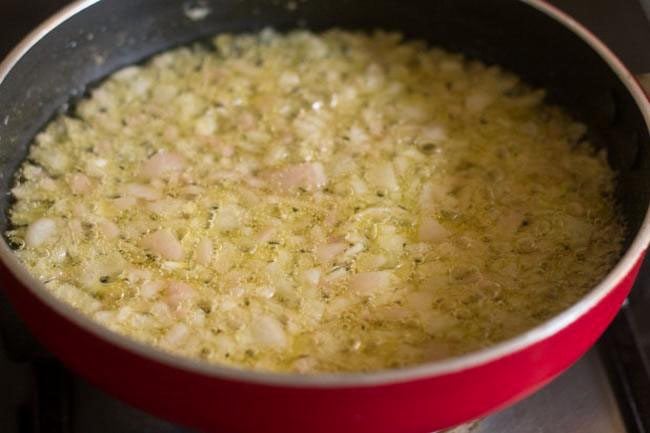
13. Then add the remaining ½ tablespoon of chopped ginger and ½ tablespoon of chopped garlic.
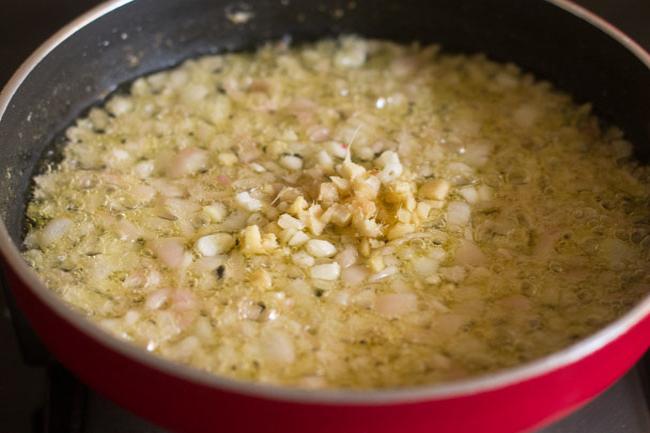
14. Also add 2 to 3 chopped green chilies or add as required. The amount of green chilies can be varied according to your spice preferences.
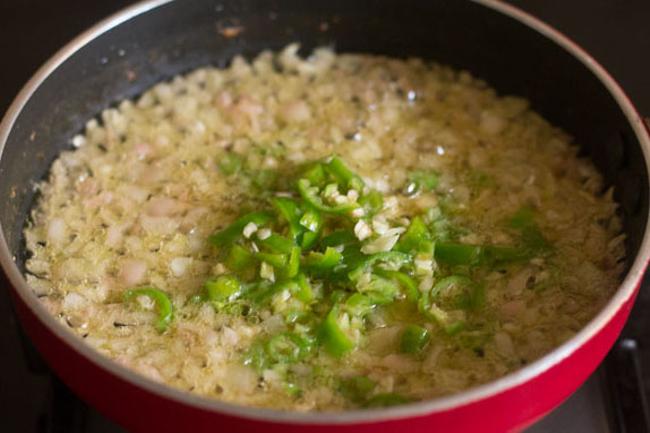
15. Stir and mix well.
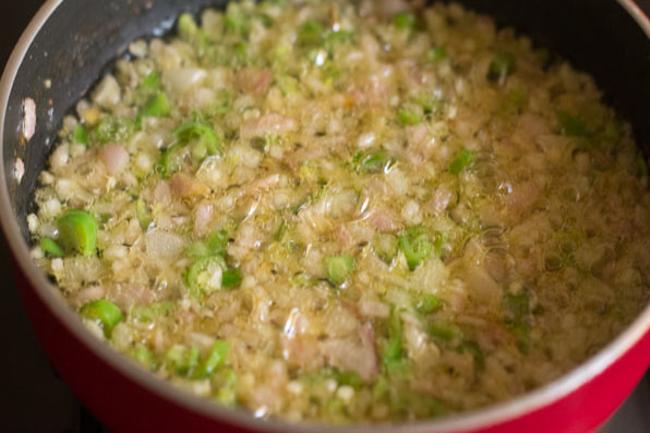
16. Saute till the onion becomes golden.
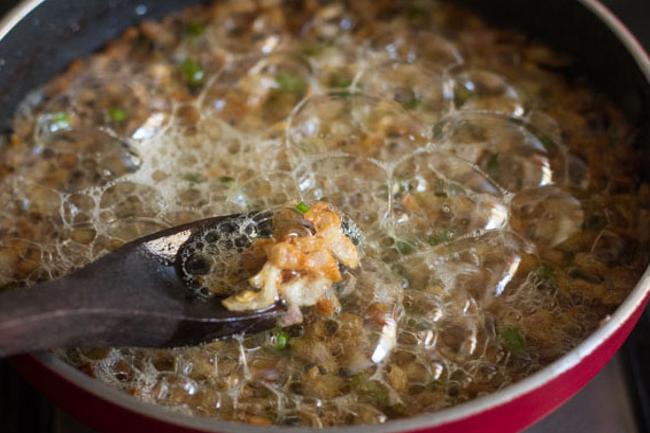
17. Then add 1 small to medium-sized chopped tomato.
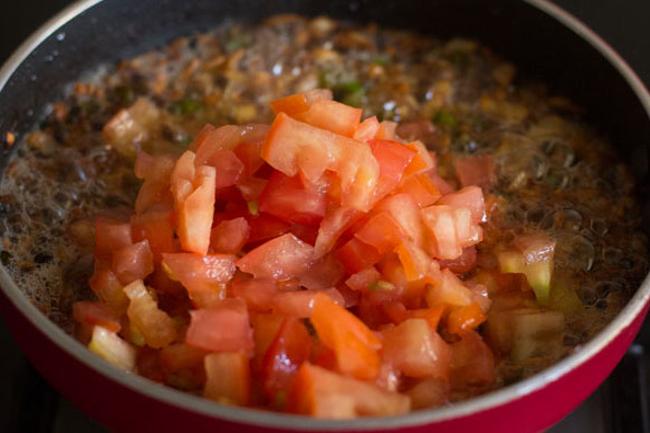
18. Stir and mix well.
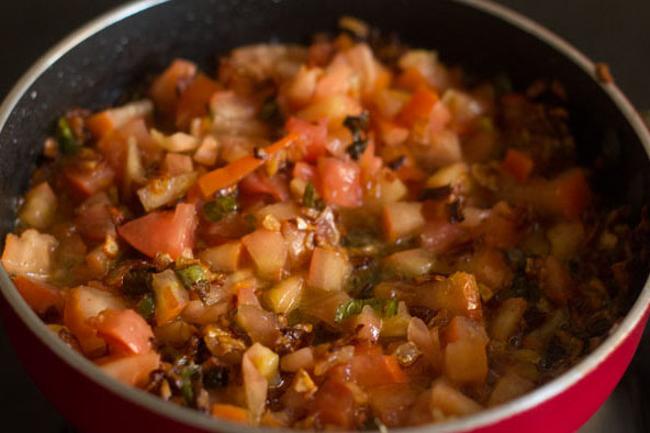
19. Add ¼ teaspoon red chili powder now if using. The addition of red chili powder is optional.
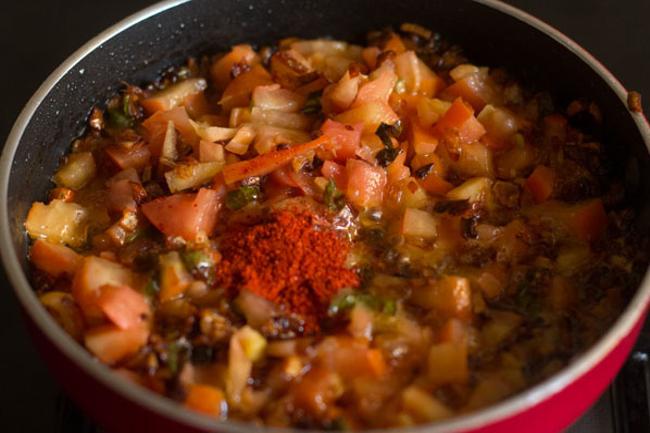
20. Stir well and saute till the tomatoes soften and oil starts to leave the sides of the mixture.
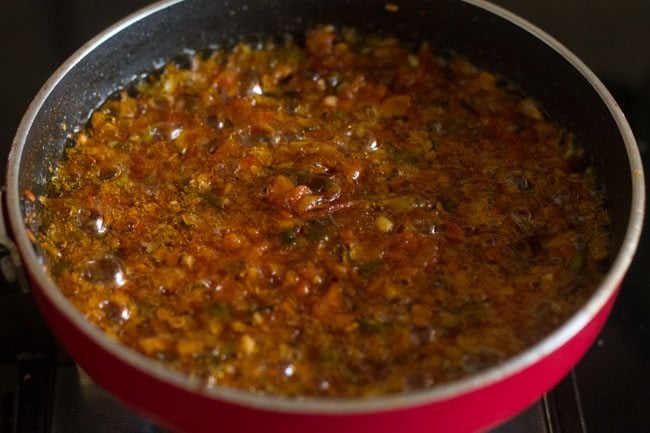
21. Pour this tempering mixture along with the oil in the cooked lentils.
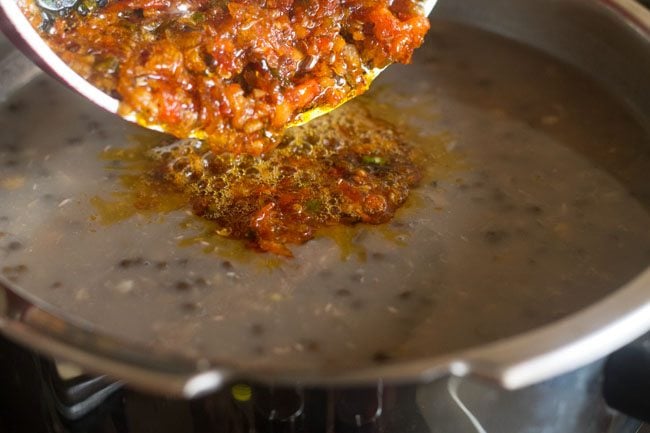
22. Stir and mix well.
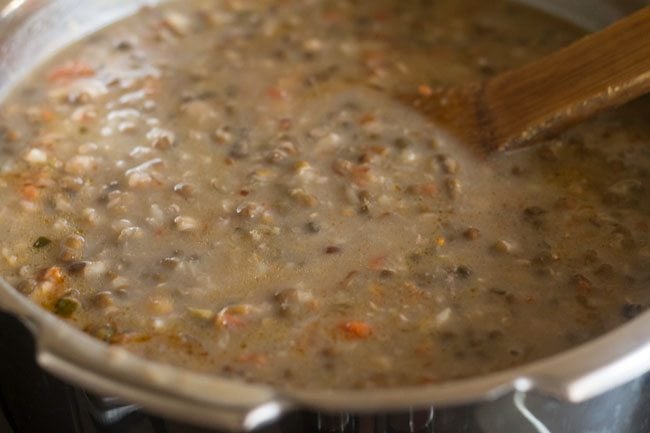
23. Then add salt as required and mix well.
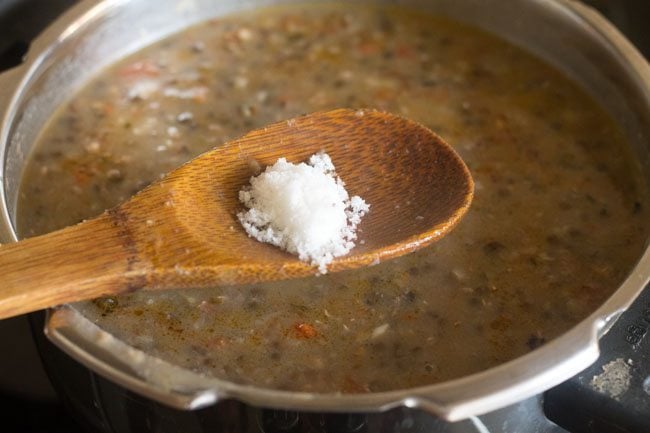
24. Simmer for 4 to 5 minutes or more till the dal thickens. Stir often when the dal is simmering so that the lentils do not stick at the bottom of the pressure cooker.
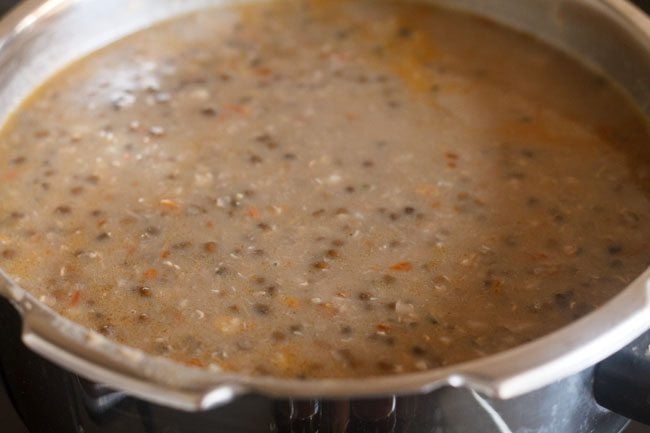
25. While simmering if the dal looks more thick, then you can add some water. Keep in mind that this dal amritsari will thicken more when it cools.
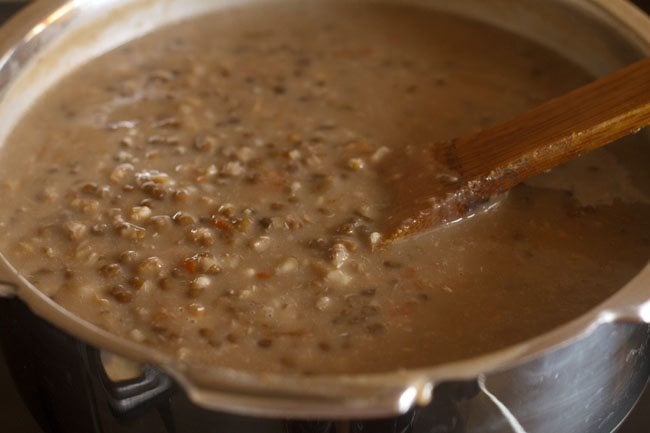
26. Continue to simmer till you get the desired consistency that is not thick or thin or runny. Garnish with 6 to 7 chopped mint leaves. You can also garnish with chopped coriander leaves.
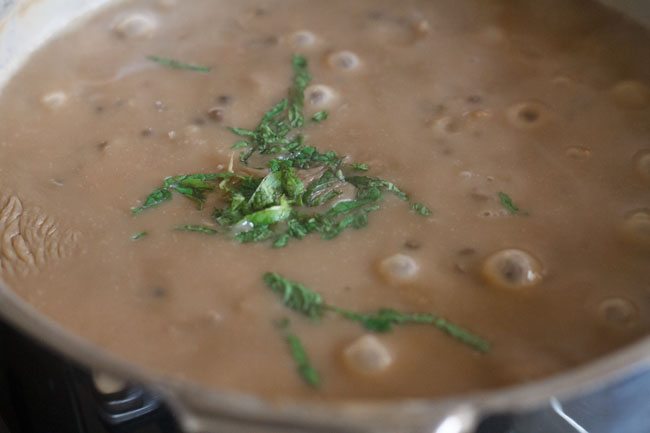
28. Top the dal with some butter according to your taste preferences.
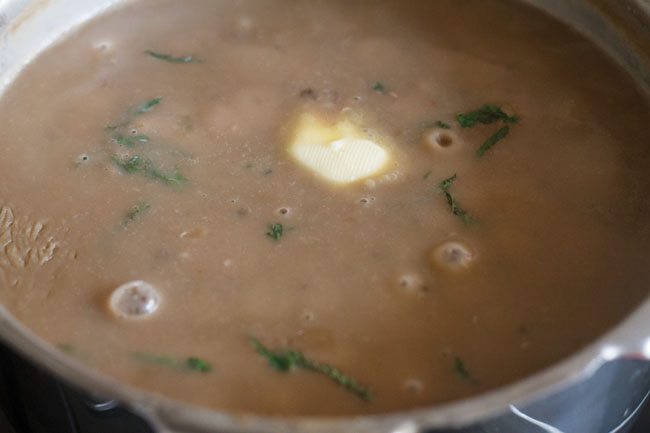
29. Serve Dal Amritsari hot or warm with roti, naan or tandoori roti or plain paratha or butter naan or steamed rice or jeera rice.
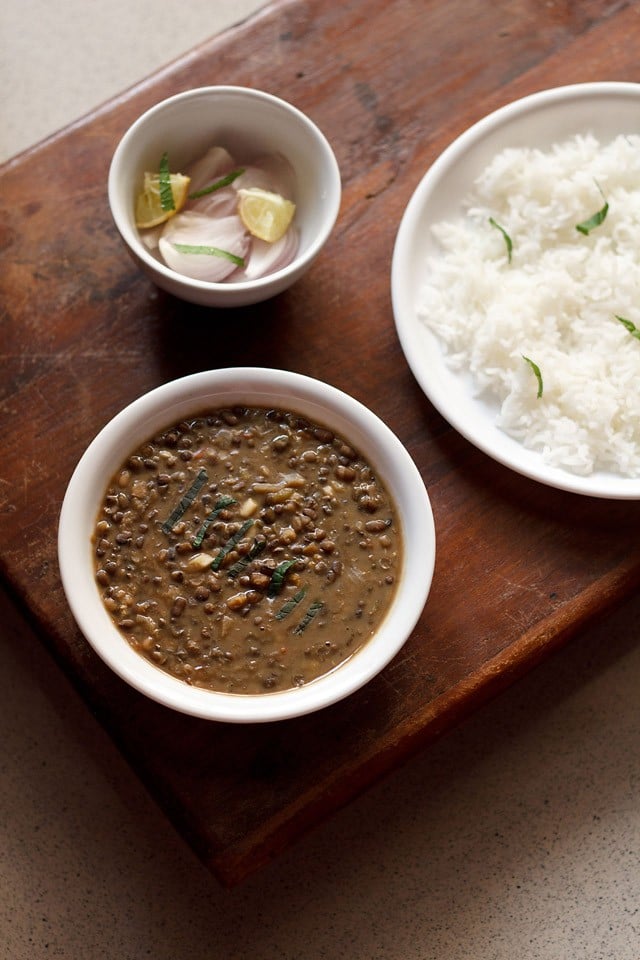
More tasty recipes for you!
Please be sure to rate the recipe in the recipe card or leave a comment below if you have made it. For more vegetarian inspirations, Sign Up for my emails or follow me on Instagram, Youtube, Facebook, Pinterest or Twitter.
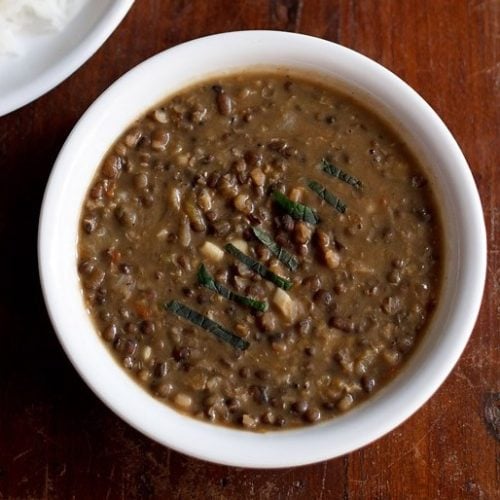
Amritsari Dal | Langarwali Dal
Ingredients
for cooking the lentils
- 1 cup whole black gram (sabut urad dal)
- ¼ cup spilt bengal gram (chana dal or split hulled black chickpea)
- 4 to 4.5 cups water for pressure cooking the dals
for tempering amritsari dal
- 2 to 3 green chilies or as required (reduce the number of chilies if you want)
- 1 small to medium-sized onion finely chopped, approx ¼ to ⅓ cup chopped onions
- 1 small to medium-sized tomato chopped, approx ¼ to ⅓ cup chopped tomatoes
- 2 tablespoon finely chopped ginger
- 2 tablespoon finely chopped garlic
- ¼ teaspoon red chili powder – optional
- 2.5 to 3 tablespoon Butter or any neutral flavored oil or ghee
- 6 to 7 mint leaves chopped or chiffonade for garnishing
- salt as required
Instructions
Cooking Lentils
- Rinse and soak the lentils in enough water overnight or for 4 to 5 hours.
- Drain the soaked lentils. In a 3 litre stovetop pressure cooker, add lentils, water, 1.5 tablespoons of chopped ginger and 1.5 tablespoons of chopped garlic.
- Pressure cook the lentils for 15 to 18 minutes on medium to medium-high heat until they are softened thoroughly. When the pressure falls down on its own in the cooker then only open the lid.
- With a back of a wooden spoon, mash some of the lentils. This helps to thicken the consistency.
Making langarwali dal
- Heat oil or butter in a small pan. Add the chopped onions. Saute till light brown stirring often.
- Then add the remaining ½ tablespoon of chopped ginger and ½ tablespoon of chopped garlic, along with the chopped chilies. Stir and mix well.
- Saute till the onions becomes golden.
- Add the tomatoes and saute till the oil starts to leave the sides of the mixture.
- Pour this sauteed onion-tomato mixture along with the oil into the cooked lentils.
- Stir and mix very well. Add salt as required. Simmer for 4 to 5 minutes or more till the dal thickens.
- While simmering if the dal amritsari looks more thick, then you can stir in some water and continue to simmer. Stir at intervals so that the dal does not stick to the bottom of the cooker.
- Once done, then garnish with 6 to 7 chopped mint leaves or 1 to 2 tablespoons of chopped coriander leaves.
- Top the dal with some butter as needed. Serve dal amritsari garnished with mint leaves.
Notes
- The recipe can be scaled to make a small batch or a large batch according to your needs.
- Use lentils that are fresh and not aged. Old lentils take a lot of time to cook and also don’t taste good.
- You can make this Amritsari dal in Instant pot following the same method and adding water as required.
- The amount of green chilies, red chili powder and butter can be varied according to your taste preferences.
- You can also choose to add cream if you prefer.
Nutrition Info (Approximate Values)
This Dal Amritsari post from the blog archives first published in August 2013 has been republished and updated on 18 January 2022.
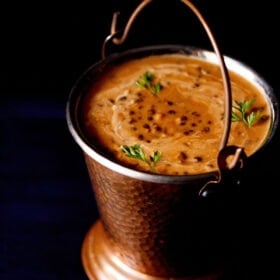
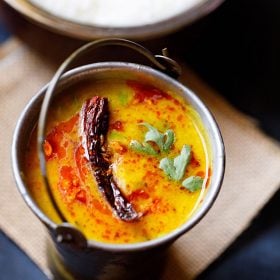
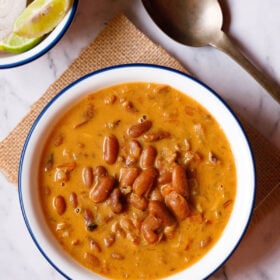
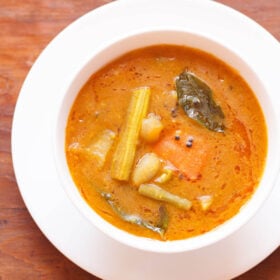








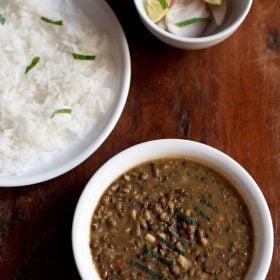
Dassana, I love all of your recipes, and so does my entire family. So authentic and delicious! It’s like the Indian food bible for us, we almost never use anything else.
Your website really helps so many people, it’s a God send. I wish you a happy, healthy, and prosperous new year!
Thanks so much. Happy and glad to read your lovely comment. Wish you too a happy, healthy and prosperous New Year.
Hey! I wanted to ask something if I don’t have much time to soak the lentils or just have 1/2hr so will that still b okay to cook?
soak in hot water for at least 1 to 2 hours.
Wow! Langar wali Dal! I agree with Your point that the Dals are such a staple in the North Indian cuisine. And surprisingly, every day the husbands need a new variety in the Dals too. And here I am with this recipe in my hands. I’m definitely going to try this. Hope it turns out to be as good as the ones served in Langar. Will cook while playing shabad in the background. ?
thanks garima. good idea.
Can this dal be prepared with white Tur dal also?
janani, i don’t think so.
hi dassana
isn’t langar food made without garlic and onions?
in langars they don’t add, but when making at home you can add.
Hi Dassana, this dish is simple yet tasty but i wanted to know “what is chiffonade called in Hindi and Telugu??”.
thanks siris. chiffonade is a way the green leafy vegetables or herbs are chopped.
Hey Dassana
First I love ur name and u have an awesome website. I have cooked so many items from here now i dont know on which one to leave a comment!
Thank u so much for making cooking so easy!
PS: i am a girl with a boy’s name 😛
welcome satya. thanks for your sweet and positive feedback. you have a beautiful name with a deep meaning.
Is it okay to use split black urad dal?
sandhya, the taste and texture both will change.
Helo dassana .u said .when i boil only dal.that time we use ginger garlic .how
when you add dal to the cooker. that time also add the ginger-garlic. just add half or three fourth from the 2 tbsp of each mentioned. then add remaining when sauteing.
Are the mesurements for ginger and garlic supposed to be in teaspoons (tsp) or tablespoons (tbsp). I think you might have it incorrect for the amritsari dal recipe. nice website…
the measurements are correct. its 2 tbsp each of ginger & garlic.
Thanks for your webite made cooking really easy
welcome mani
Can this be made in a crockpot? If yes, should I still soak the dal overnight or can I let it cook for 4-5 hours in the crockpot itself?
better to soak the lentils. they will cook faster. you can make in the crockpot.
Hey dasanna i have become a regular at vegrecipesofindia and this one recipe is my all time favourite, sp. when the cook is on leave.
YES 5 chillies is mandatory;)
thanks kanika. keep visiting.
What would be the method if one wanted to slow cook? Great website btw!
cook the soaked lentils in a deep pot or handi with about 8 to 9 cups of water. first bring to a boil and then simmer on a low flame. while simmering add some of the ginger and garlic and cover and cook the lentils.
I liked this recipe and also often make this dal with my years old family recipe but I have to admit that nothing tastes like the one you get in langaars in gurudwaaras. Same goes for the kadah prasad in gurudwaras. Have tried to replicate the recipe at home many times but cant get even close to it.. Guess it’s the prayers that make the food taste so yummy!
i agree. dal and kadah served in gurudwaras taste awesome. may be because they cook it with lot of devotion and love.
Love all kinds of punjabi dishes and this one is one of my favorites. 5 green chili, wow I think so I ll start with 1 😉 thanks for sharing Dassana.
the 5 green chilis when i read the recipe, were even too much for me. but when i made with less number of chilis, the flavors did not come through. so i now i have stuck to adding 5 chilies every time i make this dal. it does taste too bland if one or two chilies are added. at least does not go well with the indian taste buds 🙂
The dal is looking incredibly good. .
thanks suhani